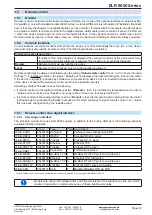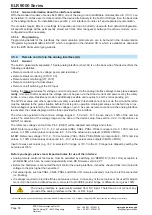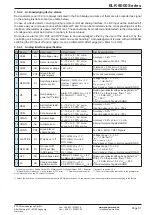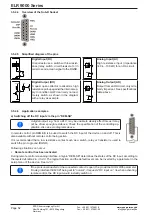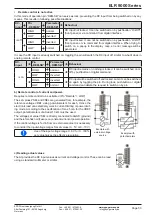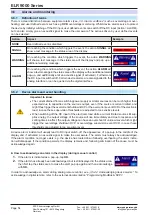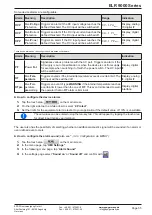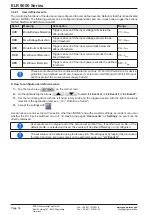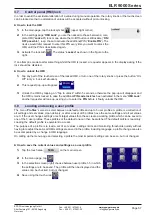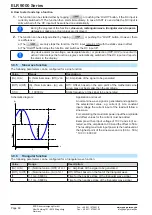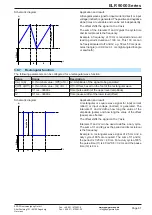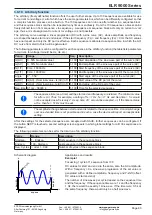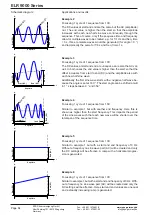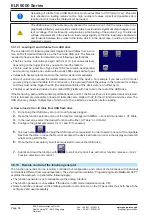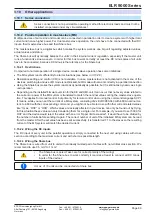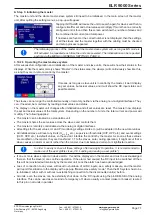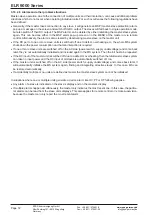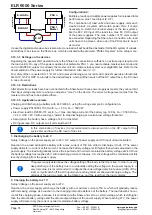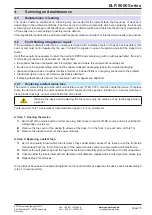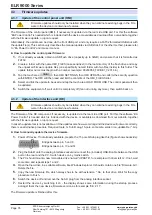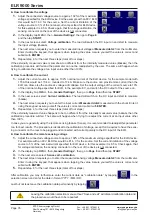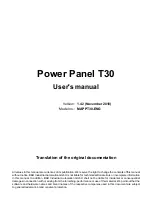
Page 63
EPS Stromversorgung GmbH
Alter Postweg 101 • 86159 Augsburg
Germany
Fon: +49 821 / 570451-0
Fax: +49 821 / 570451-25
ELR 9000 Series
3.9.10 Arbitrary function
The arbitrary (freely definable) function offers the user further scope. Up to 100 sequences are available for use
for current I and voltage U, all of which have the same parameters but which can be differently configured so that
a complex function process can be built up. The 100 sequences can run one after another in a sequence block,
and this sequence block can then be repeated many times or endlessly. From the 100 sequences a block can be
freely defined to run from sequence x to sequence y. A sequence or sequence block acts only on current or volt
-
age, thus a mix of assignment to current I or voltage U is not possible.
The arbitrary curve overlays a linear progression (DC) with a sine curve (AC), whose amplitude and frequency
are shaped between start and end values. If the start frequency (Fs) = end frequency (Fe) = 0 Hz the AC values
have no impact and only the DC part is effective. Each sequence is allocated a sequence time in which the AC/
DC curve from start to finish will be generated.
The following parameters can be configured for each sequence in the arbitrary function (the table lists parameters
for current, for voltage it would be Us, Ue etc.)
Value
Range
Seq. Description
Is(AC)
0...50% Nominal value I
1-100 Start amplitude of the sine wave part of the curve (AC)
Ie(AC)
0...50% Nominal value I
1-100 End amplitude of the sine wave part of the curve (AC)
fs(1/T)
0 Hz...10000 Hz
1-100 Start frequency of the sine wave part of the curve (AC)
fe(1/T)
0 Hz...10000 Hz
1-100 End frequency of the sine wave part of the curve (AC)
Angle
0 °...359 °
1-100 Start angle of the sine wave part of the curve (AC)
Is(DC)
Is(AC)...(Nominal value - Is(AC)) of I 1-100 Start value of the DC part of the curve
Ie(DC)
Ie(AC)...(Nominal value - Ie(AC)) of I 1-100 End value of the DC part of the curve
Seq.time 0.1 ms...36000 s
1-100 Time for the selected sequence
The sequence time (seq. time) and the start and end frequency are related. The minimum value
for
Δ
f/s is 9.3. Thus, for example, a setting of fs = 1 Hz, fe = 11 Hz and Seq.time = 5 s would
not be accepted as
Δ
f/s is only 2. A seq. time of 1 s would be accepted, or, if the time remains
at 5 s, then fe = 51 Hz must be set.
The amplitude change between start and end is related to the sequence time. A minimal change
over an extended time is not possible and in such a case the device will report an inapplicable
setting.
After the settings for the selected sequence are accepted with SAVE, further sequences can be configured. If
the button NEXT is touched a second settings screen appears in which global settings for all 100 sequences are
displayed.
The following parameters can be set for the total run of an arbitrary function:
Value
Range
Description
Startseq.
1...Endseq.
First sequence in the sequence block
Endseq.
100...Startseq.
Last sequence in the sequence block
Seq. Cycles
∞ oder 1...999
Number of cycles of the sequence block.
Schematic diagram:
Applications and results:
St
ar
t(
D
C
)
t
A
St
art
(A
C)
Seq.time
En
d
(D
C
)
Example 1
Focussing 1 cycle of 1 sequence from 100
DC values for start and end are the same, also the AC amplitude.
With a frequency >0 a sine wave progression of the set value is
generated with a defined amplitude, frequency and Y-shift (offset,
DC value at start and end)
The number of sine waves per cycle depend on the sequence time
and the frequency. If the sequence time were 1 s and the frequency
1 Hz, there would be exactly 1 sine wave. If the time were 0.5 s at
the same frequency, there would only be a half sine wave.

